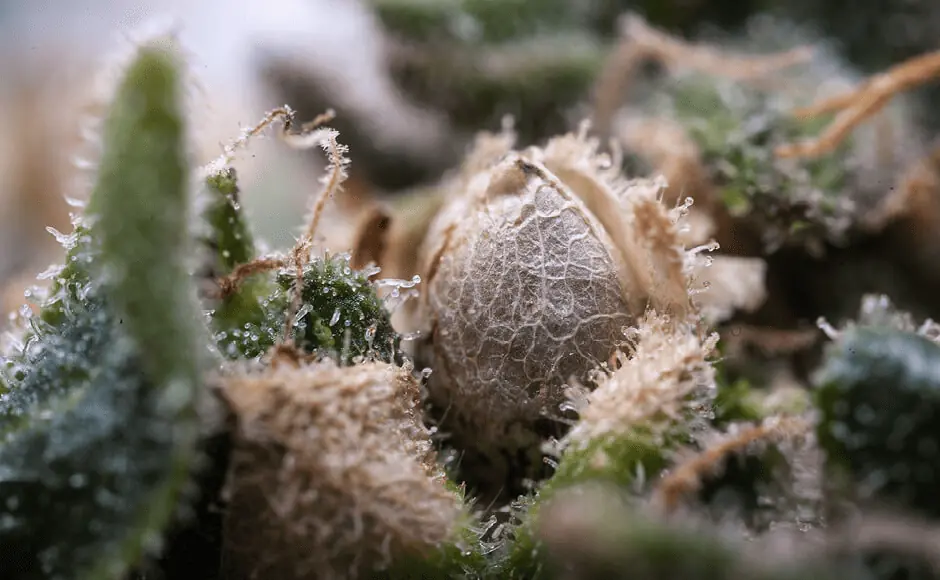Cannabis cultivation is a fascinating art that goes beyond the pursuit of abundant buds.
For those passionate about preserving specific strains, breeding new varieties, or simply exploring the wonders of cannabis genetics, learning how to harvest cannabis seeds is an essential skill.
However…
Harvesting seeds of the cannabis plant is easier said than done. It’s a meticulous process that requires a thorough approach to ensure the best quality.
If you’re clueless about harvesting your own cannabis seeds, keep on reading!
Contents
[420 NEWSLETTER]: Don't Miss The Best New Strains Hitting The Market
How Cannabis Seeds are Formed
Before we talk about the basics of harvesting, let’s briefly discuss how cannabis plants produce seeds.
Cannabis seeds are the result of successful pollination between a male and female plant.
In cannabis cultivation, male and female plants play distinct roles in the reproduction process. Male plants produce pollen sacs containing pollen, while the female cannabis plant develops pistils with stigma, style, and ovules.
During the flowering cycle, if a male plant is present in the vicinity, it releases pollen into the air or onto the flowers of females. The pollen grains travel through the air or are carried by insects, eventually reaching the pistils of the female plant.
When a pollen grain successfully lands on the stigma of a female plant, it begins to grow a pollen tube, which navigates through the style, ultimately reaching the ovules within the ovary. This process is known as pollination.
Once the pollen tube reaches the ovule, fertilization occurs, resulting in the fusion of male and female genetic material. This fertilized ovule begins to develop and mature, eventually transforming into a seed.
Male vs Female Seeds

It’s important to note that marijuana seeds themselves do not possess inherent gender. Instead, they inherit their gender characteristics from their parent plants.
Seeds produced by pollinated female plants are commonly referred to as “female seeds.” These seeds have the potential to develop into plants that carry both male and female reproductive organs.
However, those growing cannabis often use the term “female seeds” to denote seeds produced by feminized plants, which are genetically predisposed to produce only female plants.
On the other hand, “male seeds” are not a recognized term within the cannabis industry. Since a male plant does not produce flowers or buds, it does not develop seeds in the traditional sense.
Male plants primarily serve the purpose of providing pollen for pollination, initiating seed formation in females.
Types of Marijuana Seeds
It’s also essential to note that there are three types of marijuana seeds, including the following:
- Regular Seeds: These seeds have an equal chance of producing male or female cannabis plants, making them suitable for breeding purposes.
- Feminized Seeds: They are bred to produce only female weed plants, eliminating the need to identify and remove male plants during cultivation. You can also feminize your own seeds.
- Autoflowering Seeds: These seeds are genetically designed to automatically switch from the vegetative to the flowering stage, making them ideal for growers seeking quicker harvests.
Read Also: The Best Cannabis Seed Banks
A Step-by-Step Guide for Harvesting Marijuana Seeds
Here’s a quick step-by-step guide for harvesting seeds from your cannabis plant:
- Prepare for Harvest: Gather sharp scissors, clean containers, and labels for strain identification.
- Monitor Plant Maturity: Ensure plants have reached full maturity. Check for seed color, hardness, and visual cues like cracked shells or open pods.
- Select and Isolate Plants: Choose plants with desired traits and isolate them to maintain genetic purity.
- Harvest Pollen: Collect pollen from matured, unopened sacs of selected male plants. Store it in a sealed container for future controlled pollination.
- Remove Seed Pods: Carefully remove seed pods or bracts from selected female plants using sharp scissors or tweezers. Handle gently to avoid seed damage.
- Clean and Separate Seeds: Clean seeds by rubbing them between fingers or using a fine sieve to remove residue. Ensure seeds are free from contaminants.
- Label and Store Seeds: Properly label containers with strain information and store them in a cool, dark, and dry place. Use airtight containers or resealable bags with desiccant packs for long-term storage.
Tips and Tricks for Harvesting Cannabis Seeds

Harvesting marijuana seeds requires precision and attention to detail to ensure the best possible outcome. To optimize the harvesting process and maintain the genetic integrity of your cannabis strains, consider the following tips and tricks:
Avoiding Cross-Pollination
To maintain the genetic purity of your strains, prevent cross-pollination between different plants.
If you have multiple cannabis varieties in close proximity, create physical barriers or isolate them to prevent the transfer of pollen. This will help preserve the distinct traits and characteristics of each strain.
Preventing Seed Damage During Harvest
Handle the seed pods and seeds with care during the harvesting process.
Avoid using excessive force or sharp objects that may cause damage to the seeds.
Gentle handling minimizes the risk of cracking or crushing the seeds, ensuring their viability and potential for successful germination.
Properly Handling and Storing Harvested Seeds
Store the seeds in airtight containers, such as glass jars or resealable plastic bags, to protect them from moisture and air.
Place desiccant packs inside the containers to absorb any excess moisture and help maintain seed freshness.
Store the containers in a cool, dark, and dry environment to extend the seeds’ shelf life.
Labeling and Organizing Seeds
Maintain proper labeling and organization of your harvested seeds to avoid confusion and maintain strain information.
Clearly label each container with the strain name, harvest date, and any other relevant details.
This will help you keep track of the genetic lineage and specific characteristics of each seed batch.
Regularly Test Seed Viability and Germination Rates
To ensure the quality and viability of your harvested seeds, periodically conduct germination tests.
This involves planting a small number of seeds under controlled conditions to observe their germination rates.
Testing the seeds will help you assess their viability and make informed decisions when selecting seeds for future cultivation.
Maintain Proper Seed Storage Conditions
Proper seed storage conditions are crucial for preserving seed quality over an extended period.
Keep the seed containers in a cool and dark location away from direct sunlight, as light and heat can degrade the seeds’ viability.
Additionally, maintain a stable temperature and humidity level to prevent fluctuations that could impact seed integrity
Harvesting When the Time Is Right

Timing is critical when it comes to harvesting seeds.
Harvesting too early can result in underdeveloped seeds with low viability, while waiting too long may lead to maturity past their prime.
It’s crucial to observe the plants closely and look for specific signs indicating the ideal time for seed harvest.
Plant Maturity
Before harvesting marijuana seeds, it’s essential to ensure that the plants have reached full maturity.
This means allowing them to complete their flowering stage and giving the seeds ample time to develop fully. Prematurely harvested seeds may not germinate or produce healthy plants.
Seed Color and Hardness
One way to gauge seed maturity is by observing their color and hardness.
Mature seeds typically exhibit darker colors, such as brown or gray, indicating that they have reached their full potential. Additionally, mature marijuana seeds tend to have harder shells compared to immature seeds.
Gently press the seed between your fingers to assess its firmness. If it feels firm and resistant to pressure, they are likely ready for harvest.
Trichome Development
Trichomes are resinous structures that appear as tiny, crystal-like glands on the buds and leaves.
While trichomes are commonly associated with the potency of cannabis buds, they can also provide insights into seed maturity.
As the seeds approach maturity, the trichomes on the surrounding buds may change in color, becoming amber or cloudy.
Observing trichome development can help you identify the optimal time to harvest.
Seed Pods or Bracts
Inspecting the seed pods or bracts can offer visual cues to determine seed ripeness. Seed pods are small, tear-shaped structures that house the seeds within the buds.
As they mature, the seed pods may start to split open, exposing the interior.
Additionally, the bracts surrounding the seed pods may change in color, darkening or browning, indicating that they nearing their prime.
Seed Ripeness Indicators
When examining the seeds, look for specific indicators of ripeness.
Mature seeds typically have cracks, grooves, or lines on their shells.
These visual cues suggest that the seeds have completed their development and are ready to be harvested.
Conclusion
Harvesting weed seeds is an essential skill for cultivators and enthusiasts alike.
With the knowledge and techniques shared in this comprehensive guide on how to harvest cannabis seeds, you are equipped to embark on this rewarding endeavor.
By ensuring plant maturity, recognizing signs of seed ripeness, and employing proper handling and storage methods, you can preserve the genetic integrity of your favorite strains.
So, venture forth confidently into the world of seed harvesting and unlock a realm of possibilities in cannabis cultivation.
Frequently Asked Questions
What do ripe marijuana seeds look like?
Ripe marijuana seeds typically have a darker color, such as brown, and may exhibit cracks or stripes on the seed shell.
How long does it take for cannabis seeds to mature?
On average, it takes around 8 to 12 weeks from the start of flowering for seeds to fully mature. However, some strains may require longer periods, while others may mature more quickly.
Do marijuana seeds mature after harvest?
No, marijuana seeds do not mature after harvest. Once the seeds have been harvested from the plant, they are already fully matured and developed.
[420 NEWSLETTER]: Don't Miss The Best New Strains Hitting The Market

